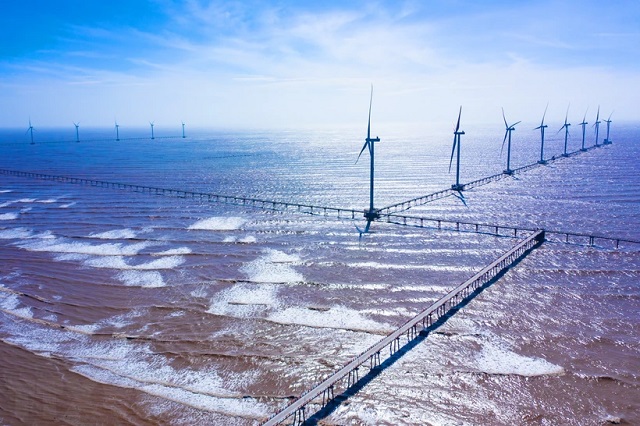
Wind turbines of the Dong Hai I Wind Power Plant. (Photo: TTXVN)
|
With zero carbon emissions and high energy conversion efficiency, producing Green Hydrogen from offshore wind power is an optimal solution that many countries around the world are adopting for energy transition.
This is also one of the breakthrough solutions that Vietnam aims to achieve to reduce net emissions to 0 by 2050.
Energy transition orientation
According to Deputy Minister of Industry and Trade Nguyen Sinh Nhat Tan, hydrogen has been recognized worldwide as a clean energy source that is essential in the energy mix of many countries to achieve carbon neutrality by 2050.
As of the beginning of 2023, more than 40 countries have issued National Hydrogen Strategies along with significant financial support policies to develop the hydrogen industry.
In particular, the EU aims to achieve a share of 13-14% of Green Hydrogen in its energy mix by 2050, while Japan and South Korea aim to develop clean hydrogen, including Green Hydrogen and Blue Hydrogen, accounting for 10% and 33% respectively in their national energy mix by 2050.
In Vietnam, the development direction of hydrogen energy has been directed by the Politburo through Resolution No. 55-NQ/TW on February 11, 2020 on the orientation of the national energy development strategy of Vietnam to 2030, vision to 2045 and Decision No. 893/QD-TTg on July 26, 2023 approving the National Energy Master Plan for the 2021-2030 period, vision to 2050.
With this orientation, the Ministry of Industry and Trade is seeking opinions to develop the Hydrogen Production Strategy and implement offshore gas and offshore wind projects.
According to the Draft Hydrogen Energy Strategy until 2030, vision to 2050, Vietnam will promote the development of hydrogen energy and hydrogen-based fuels in areas with potential and renewable energy advantages, close to large consumer markets to establish a comprehensive hydrogen industry ecosystem from production to storage, transportation, distribution, and utilization of hydrogen; striving to produce hydrogen from renewable energy sources for Green Hydrogen production; and capturing 100-500 thousand tons of carbon from other processes by 2030 and targeting about 10-20 million tons by 2050.
The draft also proposes the development direction of the hydrogen industry ecosystem, including hydrogen production, utilization, and infrastructure for hydrogen storage, transportation, and distribution, with the hydrogen production capacity from renewable energy and other processes reaching about 100-500,000 tons per year by 2030; and aims to apply and master advanced technologies for the production and utilization of Green Hydrogen in Vietnam by 2050.
Early development of clean hydrogen policies
According to the Vietnam Petroleum Institute (VPI), until 2025, the cost of producing clean hydrogen (including Blue Hydrogen and Green Hydrogen) is still very high. Specifically, the cost of producing Blue Hydrogen and Green Hydrogen in Vietnam is still 1.3 and 2.1 times higher respectively than grey hydrogen (hydrogen produced from fossil fuels such as natural gas or coal, accounting for about 95% of hydrogen production worldwide).
Therefore, in order for clean hydrogen to be developed and improved in Vietnam, the implementation of support policies from the Government is necessary to ensure the competitiveness of clean hydrogen sources.
Specifically, support policies for hydrogen development should aim to reduce investment risks by including hydrogen in the national energy plan to create a legal framework and priority list for hydrogen development projects and related fields; implementing preferential tax rate policies; developing standards, technical regulations, and safety regulations to ensure the synchronized development of the hydrogen value chain.
In addition, support policies for hydrogen development should create demand for hydrogen in the national economy, such as: providing financial support for infrastructure development projects to serve hydrogen value chain development; applying CO2 taxes to increase the competitiveness of clean hydrogen…
With the advantage of production network and supply chain in developing Green Hydrogen, the Vietnam Oil and Gas Group (PVN) has participated in the process of formulating strategies and policies to create the necessary legal framework for hydrogen development.
Through the long-term scientific and technological research program, PVN focuses on researching new technologies in the production, transportation, storage, and utilization of hydrogen to be ready to participate in hydrogen production and business when the market conditions are sufficient.
Currently, PVN’s subsidiaries such as Binh Son Refining and Petrochemical Company (BSR), Nghi Son Refinery and Petrochemical Limited Liability Company (NSRP), Petroleum Fertilizer and Petrochemical Corporation (PVFCCo), and PetroVietnam Fertilizer and Chemicals Corporation (PVCFC) have experience in producing grey hydrogen.
In addition, PVN has a pipeline transportation and distribution system, storage facilities, fuel retail outlets, and experience in operating a natural gas system that can be converted for use in the hydrogen sector.
Regarding the utilization of hydrogen, PVN’s refineries and fertilizer plants are direct consumers of Green Hydrogen to gradually replace the current grey hydrogen source.
In addition, with the extensive experience in offshore oil and gas exploration and operation, PVN and its subsidiary, PetroVietnam Technical Services Corporation (PTSC), are implementing offshore wind projects to lay the groundwork for the development of Green Hydrogen.
At present, PTSC is the first Vietnamese enterprise to be granted a license by the Ministry of Natural Resources and Environment of Vietnam for monitoring, surveying, and evaluating marine resources (survey permit), and PTSC’s partner, Sembcorp Utilities Pte Ltd (SCU), has received an In-Principle Approval letter from the Singapore Ministry of Trade and Industry for a 2.3 GW offshore wind farm project in Vietnam to export 1.2 GW to “Lion Island”.
PTSC’s General Director Le Manh Cuong said that the cost of offshore wind power production is still high globally. However, building offshore wind farms linked with the development of a Green Hydrogen production system will bring efficiency.
Anh Nguyen












